Long Pepper Roots – Piplamool – Health Benefit
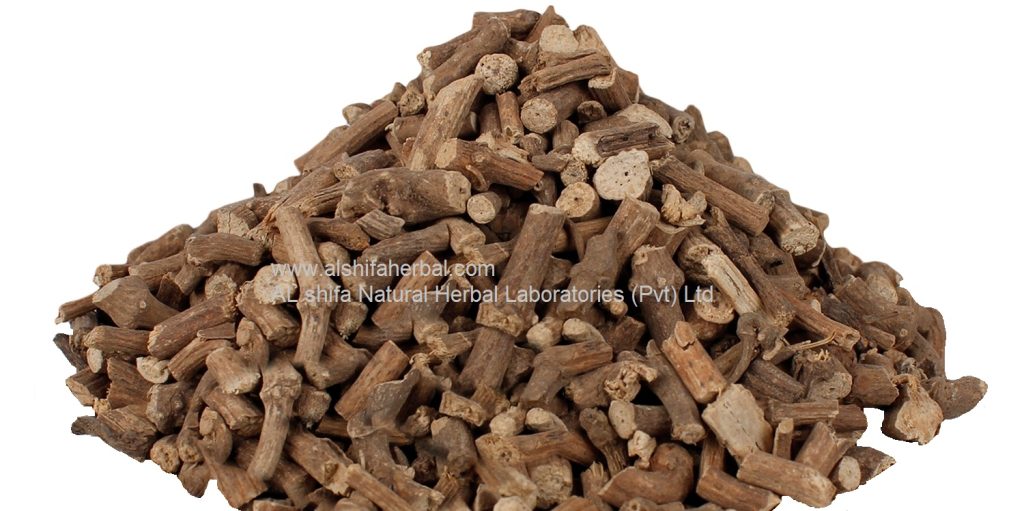
The fruits of plant Piper longum are known as Pippali/Pipri and the roots as Pippali or Pippala Mool. Both are used for medicinal purpose in Ayurveda. The roots are anti-inflammatory, analgesic, carminative, laxative, and expectorant. They are hot in potency and used to treat diseases that occur due to vitiation of Vata (air) and Kapha (phlegm) Dosha/humour. Due to hot potency the roots are used in digestive weakness and excessive phlegm inside body.
Pippali roots relieves inflammations, edema and restores the structures of the body to normalcy, improves appetite, and relieves flatulence. It is stomachic, digestive, pungent, hot, and very useful for digesting food, bile producing and laxative.
Pippali Moola has milder effects than Pippali. It is available in small cylindrical pieces of nodal and internodal pieces, about 2 mm thick. The nodal pieces are considered superior to intermodal ones.
General Information
Piper longum is perennial herb with a thick, erect, jointed, branched rootstock, stems numerous 60—90 cm long,, ascending or prostrate (not climbing), much branched, stout, cylindrical, thickened above nodes, finely pubescent.
The leaves are simple, alternate, numerous, 3.7—8.7 cm long, lower ones broadly ovate, very cordate with broad rounded lobes at base, upper ones oblongoval, cordate at base, all subacute, entire, glabrous, thin, bullate with reticulate venation sunk above and raised beneath, dark green and shining above, pale and dull beneath, petioles of lower leaves 5—7.5 cm long, stout, of upper ones very short or none, stipules about 1.2 cm long, membranous, lanceolate, obtuse, enclosing the bud but soon falling off.
flowers naked, unisexual, dioecious, sessile in axils of fleshy bracts supported by two lateral bracts arranged in solitary, pedunculate spikes, male spikes slender, bracts narrow, female spikes 1.2—2.5 cm long, bracts circular, flat, peltate, perianth absent, stamens 2, anther 2-celled.
Ovary superior unilocular with a solitary erect ovule, stigmas 3 or 4, short, spreading, persistent.
Fruit very small ovoid, completely sunk in solid fleshy spike which is 2.5—3.7 cm long, ovoid-oblong, erect blunt, blackish green and shining.
Root is greyish brown in colour,longitudinally wrinkled and having roots and root scars on the surface. It is stout, cylindrical, 0.2-0.6 cm thick, reddish brown to grey. It is aromatic and tastes pungent.
Scientific Classification
The botanical name of Pippali is Piper longum. It belongs to plant family Piperaceae.
Piperaceae is a large tropical family, having more than 10 genera and approximately 1500 species. This family belongs to class dicotyledons but due to its unique anatomical features it resembles monocotyledon.
Piperaceae family comprises of two larger genera, Piper and Peperomia. The genus Piper, the largest in the family, occurs throughout the tropical and sub-tropical regions. Most important economic species of this genus include Piper nigrum, Piper betle (Paan / Betle leaf), Chavya (Piper cubeba) and Piper longam (Pippali / long pepper). Below is given taxonomical classification of plant.
- Kingdom: Plantae – Plants
- Subkingdom: Tracheobionta – Vascular plants
- Superdivision: Spermatophyta – Seed plants
- Division: Magnoliophyta – Flowering plants
- Class: Magnoliopsida – Dicotyledons
- Subclass: Magnoliidae
- Order: Piperales
- Family: Piperaceae – Pepper family
- Genus: Piper L. – pepper
- Species: Piper longum
- Part(s) used for medicinal purpose: The fruits and Roots
- Plant type: Herb
- Habitat: Hotter parts of India
Distribution: From the central Himalayas to Assam, Khasi and Mikir hills, lower hills of Bengal, evergreen forests of Western Ghats from Konkan to Travancore, also the Car Nicobar Islands.
Also cultivated in Afghanistan, Sri Lanka, Pakistan, Malaysia and Singapore.
Constituents of Piper longum
Piper longum root gave the alkaloids piperine, Piplartine (piperlongumine) and piperlonguminine,
sesamin, methyl-j, 4, y-trlmethoxycinnamate.
Piperine has hypotensive, antipyretic, CNS-stimulant, analeptic activity. It improves availability of medicine for absorption.
Important Medicinal Properties
The roots of Pippali plant (Pippali Mula) have anti-inflammatory and analgesic effect is nearly equal to that of Ibuprofen according to a study on animals. This indicates that Piper longum Linn root has weak opioid but potent NSAID (non-steroidal anti-inflammatory) type of analgesic activity.
Below is given medicinal properties along with the meaning.
- Antibacterial: Active against bacteria.
- Antispasmodic: Antispasmodic: Used to relieve spasm of involuntary muscle.
- Anti–inflammatory: Reducing inflammation by acting on body mechanisms.
- Anthelmintic: Expel Parasitic worms (helminths) and other internal parasites from the body.
- Analgesic: Relieve pain.
- Carminative: Preventing the formation or causing the expulsion of flatulence.
- Digestive: Digestant.
- Diuretic: Promoting excretion of urine/agent that increases the amount of urine excreted.
- Emmenagogue: Stimulates or increases menstrual flow.
- Expectorant: Promotes the secretion of sputum by the air passages, used to treat coughs.
- Laxative: Tending to stimulate or facilitate evacuation of the bowels.
- Thermogenic: Warming
Ayurvedic Properties and Action
Pippali Mula is pungent in taste (Rasa), pungent after digestion (Vipaka), and is hot in effect (Virya).
The Pungent (Katu), Hot (Ushna), Penetrative (Teekshna), Dry (Ruksha), Light (Laghu) properties (guans) act against vitiated Air Humour (Vata) and Phlegm (Kapha).
- Rasa: Katu
- Guna: Laghu, Ruksha
- Virya: Ushna
- Vipaka: Katu
- Tissues: All but bone
- Systems: Digestive, reproductive, respiratory
Action / Karma
- Deepana: Promote appetite but do not aid in digesting undigested food
- Kaphahara: Pacifies Kapha Dosha
- Pachan: Assist in digesting undigested food, but do not increase the appetite
- Pitta vardhak: Increases pitta
- Ruchikarak: Improve taste
- Vatahara: Pacifies Vata Dosha
- Vatanulomana: Takes vata / wind downward, mild laxative
Pipri mula is an Ushna Virya herb. Ushna Virya or hot potency herb, subdues Vata (Wind) and Kapha (Mucus) and increases Pitta (Bile). It has property of digestion, vomiting and purging, and gives feeling of lightness. It is considered bad for sperms and fetus.
It is a Katu Vipak herb. Vipak refers to post-digestive (effect after digestion / cooking of Rasa) effect of tastes after its mixing with digestive juices. It is the long term effect of herb.
Katu Viapk herbs / foods, pungent after digestion. It increases dryness in body. Such foods reduce fertility and Kapha. Katu vipaak has catabolic effect on body.
Important Formulations
- Panchakola Churna
- Dashamhula Taila
- Dashamhulapancakoladi Kvatha Churna
Therapeutic Uses
- Anaha (Constipation), Arsha (piles), Gulma, Udararoga (diseases of abdomen), Pliha roga (spleen disorders)
- Kshaya (Pulmonary tuberculosis), Grahani (Dysentery)
- Shvasa (dyspnoea), cough, cold, and chronic bronchitis
- Krimiroga (intestinal parasites)
- Vishama jvara (intermittent fever),
- Urustambha (stiffness of thigh), Vatavyadhi (Nervous diseases)
- Nidranasha (Insomnia), Headache
Medicinal Uses of Piper longum (Pippalimool)
Pippalimool or roots of Pippali (long pepper) plant, are used in dried powder (reddish-brown to creamy-grey bitter powder) form with warm water, milk or preferably with ghee. When used with Ghee, the drying and hot properties of Pippalamula are balanced. This combination is beneficial in headaches due to vitiation of Vata.
- For sleeplessness and high blood pressure, the Pippla Moola churna should be taken with cold water, twice a day.
- The decoction of roots is prepared by boiling the 2 tablespoon of roots in one glass water and cooking till water reduces to half cup. This is filtered and taken twice a day.
- Pippali roots can be taken in form of tea for cold, cough and congestion. For making the tea, the powder is boiled in water and sugar and milk is added.
- In case of enlarged liver and spleen, five grams root powder and one gram pippali fruit powder is boiled in 200 ml water and cooked for few minutes. This is filtered and taken.
Dosage of Piper longum
- Dose of the powder for adults is 2 to 3 grams and for children it is 250 mg to 500 mg, to be taken twice daily, preferably on an empty stomach mixed with 3 to 5 gm of ghee or butter or Honey and followed by warm water or milk.
- Contraindications, Interactions, Side-effects and Warnings Piper longum
- No toxic effect or adverse reaction is reported with recommended dose of Pippali root powder.
- It is hot in potency, it decreases Vata and Kapha and increases pitta. So it should be used carefully in person with pitta Prakriti.
- It should not be used if tissues are inflamed.
- It should be taken only in recommended doses. High doses causes burning sensation and vitiation of all Dosha.
- Avoid in pregnancy and lactation.
- Avoid in blisters, dryness and persistent bitter taste in the mouth, red eyes, hot and watery face, inflammation of the body, inflammations of the intestines and high pitta.
- Low dose is safe for long-term use.
- Do not use at a high dose for long periods of time.
Headache Treatment with Pippalimoola
Headache is pain in upper head part can be caused by many health reasons. Headache itself not a disease as it is symptom of many other diseases. It can caused by several diseases like gastric migraine, refractory error, mental tension, sinusitis, flu, viral fever, typhoid etc.
Sudden and severe headache along with symptoms like high fever, vomiting, convulsion, visual symptoms, stiffness in the neck and loss of consciousness needs urgent medical assistance. These type of headache should not be treated with home remedies. In these type of cases one should visit a doctor or hospital immediately.
Ayurvedic herbal medicine Pippalimoola is good to treat mild to moderate headache. This can be prepared at home and there is know known side effect if used as directed.
How to prepare Pippalimool and take?
Take 50 gm dried roots of long pepper and make fine powder using grinder and filter it using some cotton cloth. Store this powder in air tight jar. Make sure that herb is not older than 1 years after harvested.
It should be take 2 times daily empty stomach with warm water, milk or preferably with clarified butter.
bimbima
Anupama Prabhakar
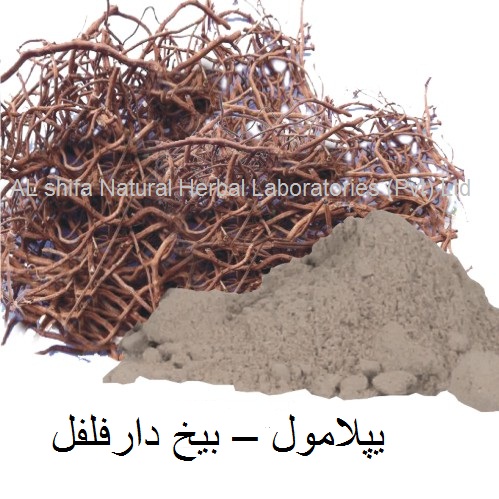
Piplamool, Long Pepper Root
پیپلامول – بیخ دارفلفل – اصل الفلفل – بیخ فلفل بلند – بیخ فلفل مویه
ماہیت ۔ فلفل دراز کی جڑیں گرہ دار سخت وزنی اورشکل اسارون کی جڑ سے ملتی جلتی ہیں ۔ لیکن یہ چرچٹہ کی جڑ سے وزنی ، تیزوتلخ اور چریری ہوتی ہے ۔
رنگت ۔ مٹیالی یا خاکستری سیاہی مائل ہوتی ہے۔لیکن توڑنے پر اندر سے سفید نکلتی ہے۔بازار میں شاخوں اور جڑوں کو ملا کر ہی پیلا مول بیچاجاتا ہے۔
مقام پیدائش ۔ راجپوتانہ ، دکن ،نیپال،آسام ، کھاسیہ ، کی پہاڑیاں ، بنگال ، بمبئی کے علاقے سیلون ،گجرات ملپائن بہار ہمالیہ کی تہلیٹی نینی وغیرہ کے گرم حصوں اور ملکوں میں پائی جاتی ہے ۔ ایک بارکی بوئی ہوئی بہت دیر تک پھل دیتی ہے۔
مزاج ۔ گرم خشک درجہ دوم ۔
افعال ۔ مقوی معدہ کاسرریاح ، مقوی باہ مسخن و محلل ، جالی ۔
استعمال ۔ پیپلامول پیپل سے زیادہ مقوی ہے ۔ ضعف معدہ ضعف اشتہا ،معدے کے ریای درد قولنج اور نفع شکم میں استعمال کیاجاتا ہے۔ مقوی باہ نسخوں میں شامل کرتے ہیں ۔ سردنقر س اور صلابت جوڑ میں اس کا لیپ لگاتے ہیں ۔ چہرے کا رنگ نکھارنے کیلئے اس کو پیس کو طلاءکرتے ہیں ۔ اس کا چبانا رطوبت منہ کی چھانٹناہے ۔ پیپلا مول کی جڑ کو جوشاندہ زچہ کو وضع حمل کے فوراًبعد پلایاجاتاہے ۔ تاکہ آنول پورے طور پر خارج ہوجائے
کھانسی اوردمہ میں شہد میں ملا کر چٹاتے ہیں ۔ چند عدد پیپلا مول کو ایک بکری کے جگر میں چھبو کر آگ پر گرم کریں اس سے جو پانی نکلتا ہے۔ آنکھ میں لگانے سے پھولا ناخونہ کیلئے سفید ہے۔
فوائد خاص ۔ مقوی معدہ ۔ہاضم ۔
مضر۔ منی اور بینائی کو کم کرتا ہے ۔
مصلح ۔ گوند کیکر میں صندل سفید ۔
بدل ۔ نارمشک ۔سورنجان ۔
کیمیاوی اجزاء ۔ اس میں ایک اڑنے والا تیل رال ،ایک چمکدارالکلائیڈ پائیرین (جوہر فلفل ) اور نشاستہ موجود ہے۔
مقدارخوراک ۔ ایک سے دوگرام تک ۔

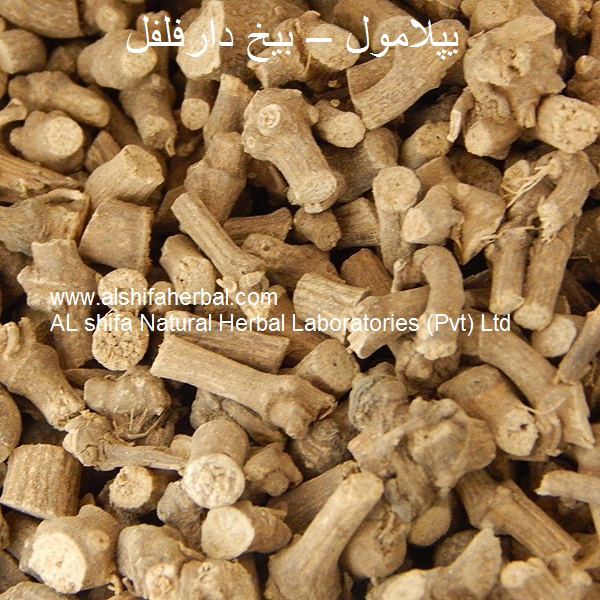
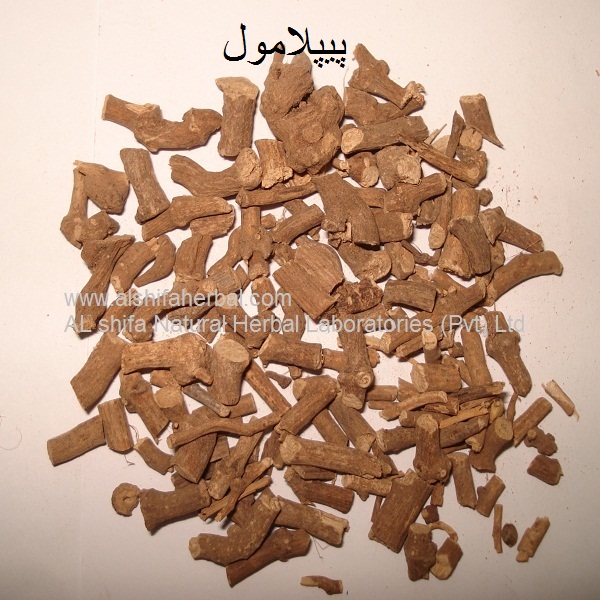
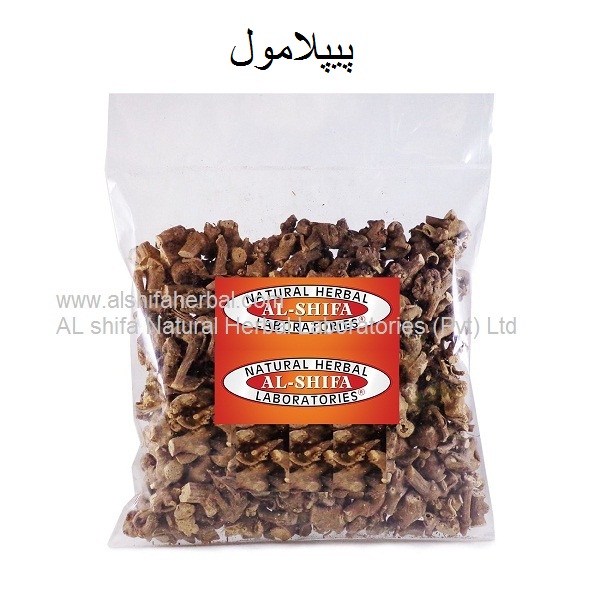
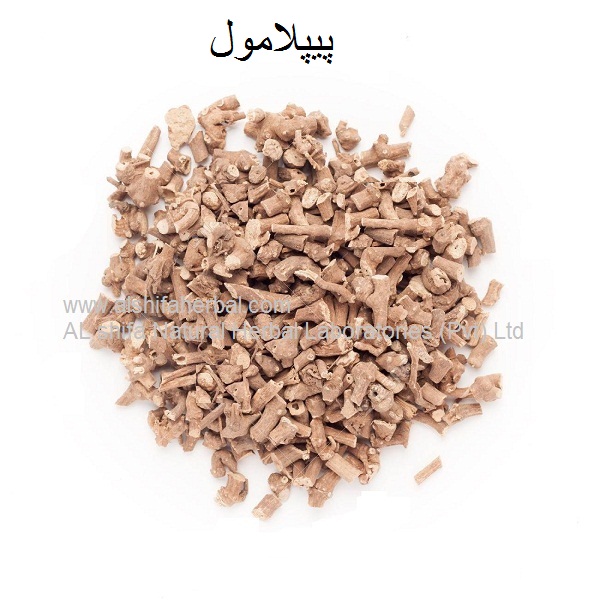
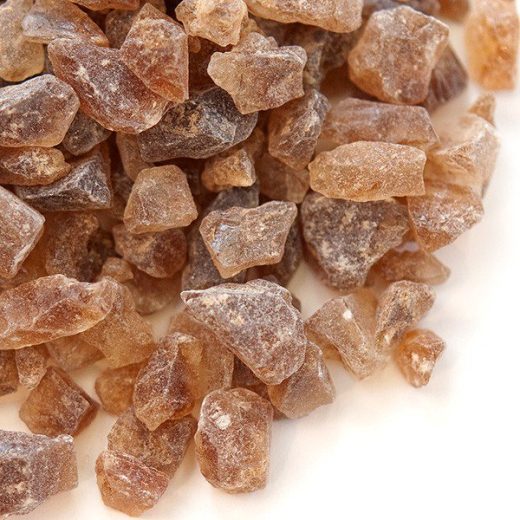
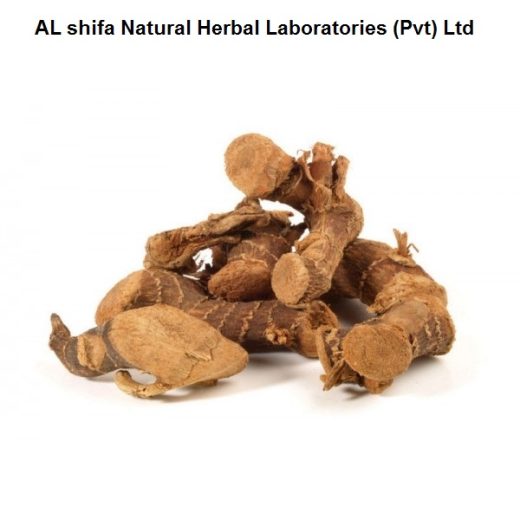
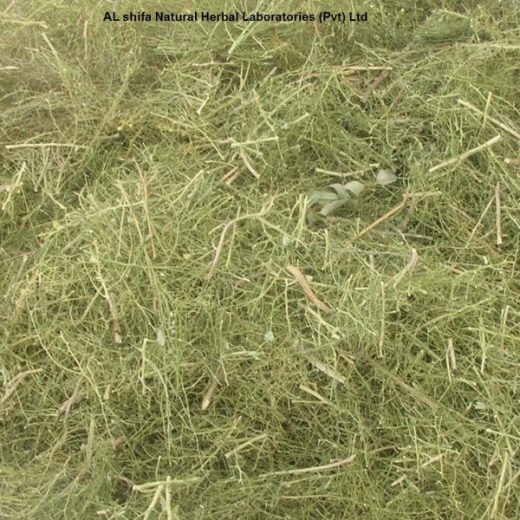



Reviews
There are no reviews yet.